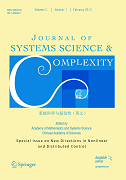WANG Yajing,WANG Xiangke,ZHAO Shulong,SHEN Lincheng
Journal of Systems Science and Complexity.
2018, 31(1):
302-324.
In this paper, a curved path following control algorithm for miniature unmanned aerial vehicles (UAVs) in winds with constant speed and altitude is developed. Different to the widely considered line or orbit following, the curved path to be followed is defined in terms of the arc-length parameter, which can be straight lines, orbits, B-splines or any other curves provided that they are smooth. The proposed path following control algorithm, named by VF-SMC, is combining the vector field (VF) strategy with the sliding mode control (SMC) method. It is proven that the designed algorithm guarantees the tracking errors to be a bounded ball in the presence of winds, with the aid of the Lyapunov method and the BIBO stability. The algorithm is validated both in Matlab-based simulations and high-fidelity semi-physical simulations. In Matlab-based simulations, the proposed algorithm is verified for straight lines, orbits and B-splines to show its wide usage in different curves. The high-fidelity semi-physical simulation system is composed of actual autopilot controller, ground station and X-Plane flight simulator in-loop. In semi-physical simulations, the proposed algorithm is verified for B-spline path following under various gain parameters and wind conditions thoroughly. All experiments show the accuracy in curved path following and the excellent robustness to wind disturbances of the proposed algorithm.
